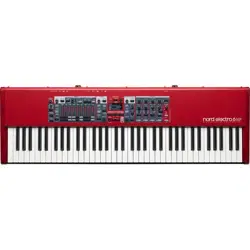Loading ...
Loading ...
Loading ...

12 | NORD ELECTRO 6 USER MANUAL OS V2.6X
THE VOX MODEL
The original Vox organ is probably the most famous of all the transis-
tor based combo organs that emerged in the early 60’s. Transistor
technology made it possible to manufacture compact and portable
organ instruments. Compared to the mighty sound of tonewheel based
organs, transistor organs generally sounded reedier and weaker, but
this one had a distinctive sound character which together with the port-
ability and cool design (inverse colored keyboard and chrome “Z-frame”
stand) made the instrument massively popular at the time. The sound is
timeless and recreated faithfully by the Nord Electro 6.
VOX DRAWBARS
The labels used for the Vox drawbars are printed on the row directly
above the drawbar LEDs.
For basic drawbar operation, please refer to “Drawbars and Buttons”
on page 10.
The seven drawbars to the left control the level of each partial. Each
partial has a fixed harmonic interval relating to the played note. The
illustration below shows the pitch interval of the drawbars when the key
of C3 is played. The intervals vary for the upper and lower manual on
the original instrument, and the Nord Electro 6 implements a combina-
tion of the two for both manuals.
The rightmost drawbar controls the mix between a filtered signal
sounding soft and dark, and an unfiltered signal sounding bright and
intense.
VIBRATO
There are several types of vibrato and choruses available for the Vox
model, which is activated using the ON button in the Vibrato section.
The V3 setting is the one that is modeled after the original instrument.
THE FARF MODEL
The typical “buzzy” sound of this vintage instrument is one of the most
distinct and easily recognizable organ sounds ever created; yet it is
actually possible to get quite a wide range of sounds out of the instru-
ment. Note that the voices aren’t supposed to replicate the instruments
they are named after, but rather to describe the basic tonal characteris-
tic of the voice: Flute = soft, Oboe = reedy, Trumpet = brassy etc.
FARF REGISTERS
The labels used for the FARF drawbars/registers are printed on the
upper row, above the drawbar LEDs or drawbars.
The drawbars act as on/off switches, or “register selectors” when the
Farf model is selected. Instead of drawbars, the original instrument
used rocker switches for selecting instrument voices (in reality different
filter settings) in various footage (octave) ranges. On the Electro 6 HP
model, drawbar LEDs 5-8 are lit up for an activated voice, and LEDs
1-4 are for a deactivated voice. On the Electro 6 D models, pulling
the drawbars more than half way out will activate the corresponding
register.
As usual, the Program section display will show current drawbar set-
tings for the Organ section. The table below shows the original register
name.
Drawbar Voice Panel Name
1 Bass 16 BASS16
2 Strings 16 STR16
3 Flute 8 FLUTE8
4 Oboe 8 OBOE8
5 Trumpet 8 TRMP8
6 Strings 8 STR8
7 Flute 4 FLUTE4
8 Strings 4 STR4
9 A bright voice, an octave
and a fifth above the
fundamental
2 2/3
The illustration below shows the pitch interval between each voice
when the key of C3 is played. Though some voices have the same
pitch, they differ in tonal character.
Vox Upper
Vox Lower
C3
C3
Loading ...
Loading ...
Loading ...
